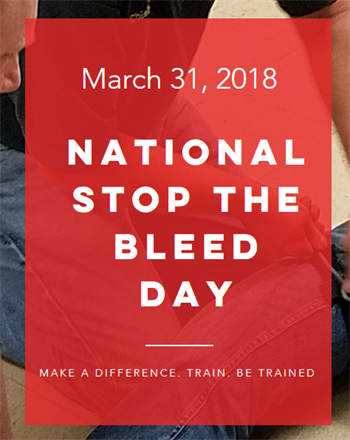National Stop the Bleed Day - March 31, 2018
Mar 31, 2018
The Stop the Bleedsm program was commissioned by the White House following the Sandy Hook disaster in Newtown, Connecticut. A joint committee of emergency responders, law enforcement, and physicians developed a national policy on increasing survivability following mass-casualty events called the Hartford Consensus. The consensus found that victims of trauma are susceptible to critical blood loss before first responders can reach the scene, and that immediate bystander care is critical in preventing survivable death, illustrated by the statistics below:
- Traumatic injury is the leading cause of death for people below age 46
- 35% of pre-hospital deaths are due to blood loss
- 80% of victims in a mass casualty event are transported to the hospital by members of the public
Death due to traumatic bleeding can occur in less than five minutes - The National Fire Protection Association (NFPA) states that emergency response should begin within five minutes
- National EMS Response times often exceed the NFPA target times
- Of the 147,000 trauma deaths in 2014, 30,000 might have survived with appropriate care, primarily control of bleeding
The Stop the Bleedsm initiative has mutual involvement from the White House, the Department of Homeland Security, the American College of Surgeons, and the American College of Emergency Physicians, who recognize that everyone has the power to stop life-threatening bleeding caused by injuries in the home, industrial settings, or mass-casualty events. State and local government, medical groups and healthcare organizations, regional and local first responders, and state coordinators share a mutual interest to inform the public that this training is available to all.
National Stop the Bleed Day is a grassroots initiative to raise awareness for the official Stop the Bleedsm program. While National Stop the Bleed Day is not working with the above-mentioned agencies, National Stop the Bleed Day is not directly affiliated. As such we do not receive funding from any source. The objective of National Stop the Bleed Day 2018 is to connect potential Stop the Bleedsm students with instructors willing to donate their time for a day of free training. Our effort is currently supported by the American College of Surgeons Committee on Trauma, Department of Homeland Security, National Associate of Emergency Medical Technicians (NAEMT), International Association of Fire Chiefs, International Association of EMS Chiefs, the International Association of Firefighters (IAFF), Committee on Tactical Combat Casualty Care, Committee for Tactical Emergency Casualty Care, and EMS.gov.
